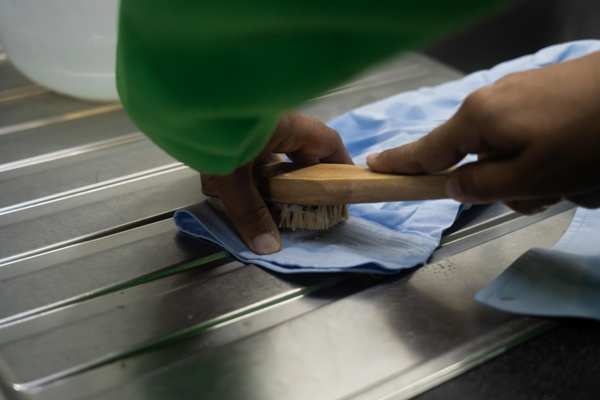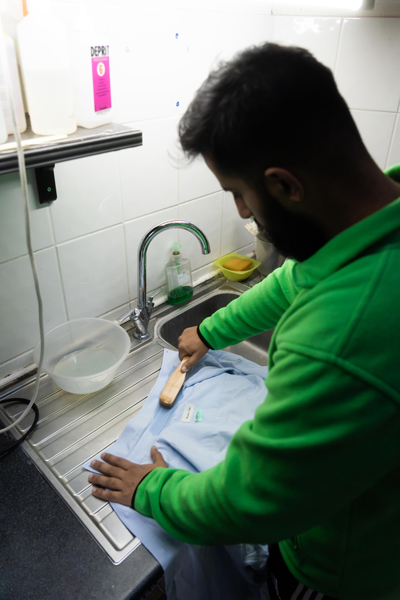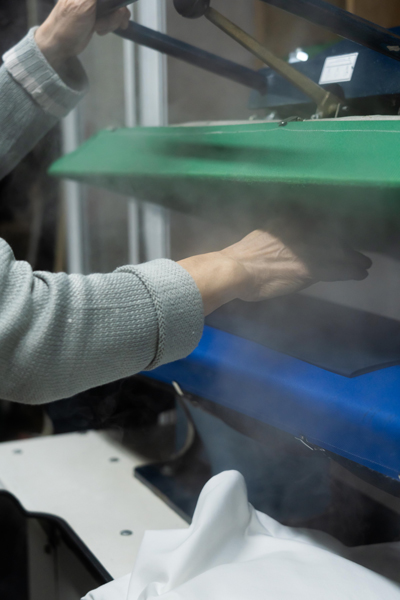Introduction

The dry cleaning process plays a crucial role in garment care, especially when it comes to stain removal. Stains can ruin the appearance and longevity of clothes, making their removal a top priority. From everyday wear to special occasions, maintaining clean and pristine garments is essential.
Dry cleaning is a specialized method that uses solvents instead of water to clean fabrics. This process is particularly relevant for delicate fabrics and intricate designs that might be damaged by traditional washing methods. The dry cleaning process ensures that stains, dirt, and odors are effectively removed without compromising the fabric’s quality.
Stains come in various forms, including organic stains like sweat and food, inorganic stains such as ink and dye, and combination stains like grease mixed with dirt. Each type of stain requires a unique approach for effective removal. This is where dry cleaning shines, utilizing advanced techniques and solvents tailored to dissolve and lift specific stains.
Understanding the dry cleaning process helps us appreciate its importance in garment care. It not only removes visible stains but also preserves the fabric, extending the life of your clothes. With professional expertise and the right equipment, dry cleaning ensures your garments remain fresh and beautiful, ready to wear for any occasion.
Detailed Analysis of Stain Types
Organic Stains
Organic stains are common and often come from biological sources:
- Blood: Contains proteins that can set quickly.
- Sweat: Leaves yellowish stains, especially on light fabrics.
- Food Stains: Often oily or greasy, making them tough to remove.
The dry cleaning process uses chemical solvents that dissolve these stains without spreading them. This is crucial for preventing water-soluble stains from setting into the fabric.
Inorganic Stains
Inorganic stains are from non-biological sources and include:
- Ink: Pen ink can be challenging due to its pigmentation.
- Dye: Spilled dyes can bond with fabric fibers.
- Paint: Paint stains are particularly stubborn, especially if dried.
Dry cleaning solvents are designed to break down these tough stains. Solvents like perchloroethylene or hydrocarbons effectively dissolve inks, dyes, and paints without damaging the fabric.
Combination Stains
Combination stains are a mix of organic and inorganic substances:
- Grease Mixed with Dirt: Common in work clothes or outdoor gear.
- Oil-based Stains with Dust: Makeup or lotion combined with dust.
These stains require a multifaceted approach. The dry cleaning process excels here by using pre-treatment methods to target both components. For instance, pre-treating with enzyme-based cleaners can break down organic components, while solvents handle the inorganic parts.
Benefits of Dry Cleaning
- Preservation of Delicate Fabrics: Materials like silk, wool, and suede benefit from the gentle dry cleaning process.
- Prevention of Shrinkage and Fading: Dry cleaning avoids the high temperatures and agitation of traditional washing, maintaining fabric integrity.
Specialized Equipment and Techniques: Dry cleaners use advanced tools to pre-treat and remove stains, ensuring optimal results.
Eco-Friendly Options
Modern eco-friendly dry cleaning methods utilize sustainable solvents, reducing environmental impact while providing excellent stain removal. These alternatives are effective and gentler on both fabrics and the planet.
By understanding the types of stains and the benefits of the dry cleaning process, you can appreciate the science behind effective garment care. Trusting professional dry cleaners ensures your clothes are treated with expertise and care, keeping them fresh and pristine.
Dry Cleaning Process: An Overview

Step-by-Step Explanation of the Dry Cleaning Process
The dry cleaning process involves several meticulous steps to ensure thorough cleaning:
- Inspection and Tagging:
- Garments are examined for stains, tears, and missing buttons.
- Each item is tagged to track it throughout the cleaning process.
- Pre-Treatment:
- Stains are pre-treated with specialized solutions tailored to their type and fabric.
- Cleaning:
- Clothes are placed in a machine and cleaned using dry cleaning solvents like perchloroethylene, hydrocarbons, or eco-friendly dry cleaning alternatives.
- The machine gently agitates the clothes, allowing the solvent to dissolve oils, grease, and other stains.
- Post-Spotting:
- Any remaining stains are treated individually to ensure complete removal.
- Finishing:
- Garments are pressed, steamed, and reshaped to restore their original appearance.
Role of Pre-Treatment and Inspection
Pre-treatment and inspection are critical components of the dry cleaning process:
- Pre-Treatment:
- Targeted stain removal ensures that specific stains are addressed with the appropriate chemicals and techniques.
- This step maximizes the effectiveness of the solvents used during the main cleaning cycle.
- Inspection:
- Initial and final inspections help identify and address any issues, ensuring garments are returned in the best possible condition.
Benefits of the Dry Cleaning Process
- Effective Stain Removal:
- Chemical solvents used in dry cleaning dissolve stubborn stains that traditional washing methods might miss.
- Fabric Preservation:
- The process is gentle on delicate fabrics like silk, wool, and suede, preventing damage.
- Prevents Shrinkage and Fading:
- Avoids the high temperatures and agitation of traditional washing machines, maintaining the fabric’s integrity.
Eco-Friendly Dry Cleaning
Modern eco-friendly dry cleaning methods use sustainable solvents that are effective and less harmful to the environment, providing a balance between excellent stain removal and environmental responsibility.
By understanding the dry cleaning process, you can appreciate its role in maintaining the quality and appearance of your garments. Trusting professional dry cleaners ensures your clothes receive expert care.
Chemical Composition of Dry Cleaning Solvents
Commonly Used Solvents
Perchloroethylene (PERC)
Perchloroethylene, commonly known as PERC, is the most widely used solvent in the dry cleaning process. It is effective for removing a wide range of stains, particularly oils and greases.
- Interaction with Stain Molecules:
- PERC dissolves oils and fats, breaking them down without affecting the fabric’s fibers. It’s particularly useful for water-insoluble stains.
Hydrocarbons
Hydrocarbon solvents are a milder alternative to PERC, suitable for delicate fabrics that might be damaged by harsher chemicals.
- Interaction with Stain Molecules:
- Hydrocarbons effectively dissolve oily and greasy stains. They are gentle on fabrics like silk, wool, and suede, preserving their integrity while removing stains.
GreenEarth
GreenEarth is an eco-friendly dry cleaning solvent made from liquid silicone. It is non-toxic and gentle on both fabrics and the environment.
- Interaction with Stain Molecules:
- GreenEarth breaks down oils and other stains similarly to traditional solvents but without harmful environmental effects. It’s safe for all types of fabrics, making it a versatile choice for stain removal.
How Each Solvent Works
- Solubility:
- These solvents dissolve various stains based on their chemical makeup, ensuring effective stain removal.
- Emulsification:
- They break down grease and oils, turning them into small droplets that can be washed away.
- Absorption:
- Solvents absorb stains from the fabric, lifting them away without water, which helps prevent water-soluble stains from spreading and setting.
Benefits of Eco-Friendly Options
- Environmental Impact:
- Eco-friendly solvents like GreenEarth reduce the environmental footprint of dry cleaning, providing a sustainable option.
- Fabric Preservation:
- They are gentle on delicate fabrics, preventing damage and extending the life of garments.
Understanding the chemical composition of dry cleaning solvents and how they interact with stains highlights the science behind effective garment care. Professional dry cleaning process ensures that your clothes are treated with the best methods, keeping them clean and fresh.
The Advantages of Modern Laundry Solutions
- Time Efficiency: Users reclaim time spent on laundry tasks, which can now be devoted to more enjoyable or productive activities.
- Customization: Modern services cater to specific laundry needs based on fabric type, color, and personal care preferences.
- Accessibility: With services available 24/7 via apps, laundry assistance is always at your fingertips.
- Eco-friendly Options: Many modern services promote sustainability, using eco-friendly detergents and optimizing resource consumption.
The convenience and customization offered by these modern laundry services are unmatched. They not only save time but also adapt to the fast-paced, varied needs of modern lifestyles. As we move forward, these innovations in laundry services are set to become even more integral to urban living, blending efficiency with environmental consciousness. This evolution marks a significant shift towards more sustainable and user-friendly approaches to managing daily tasks.
Scientific Principles Behind Stain Removal
Solubility: How Solvents Dissolve Stains
Solubility plays a key role in the dry cleaning process. Chemical solvents are used instead of water, which helps prevent water-soluble stains from spreading. These solvents, such as perchloroethylene and hydrocarbons, are designed to dissolve oils, grease, and other stubborn stains that water and detergent might not remove.
Emulsification: Breaking Down Grease and Oils
Emulsification is another critical principle. During the dry cleaning process, solvents break down grease and oils into smaller particles. This process, facilitated by solvents like GreenEarth in eco-friendly dry cleaning, turns these particles into a form that can be washed away without damaging the fabric.

Absorption: Lifting Stains from Fabric
Absorption is the final step where solvents lift stains away from the fabric. By absorbing stains, the solvents ensure they do not redeposit on the garment. This method is particularly beneficial for delicate fabrics like silk, wool, and suede, which can be damaged by water.
Benefits of the Dry Cleaning Process
- Prevents Shrinkage and Fading:
- The absence of water and high temperatures prevents shrinkage and fading, maintaining the fabric’s integrity.
- Preserves Delicate Fabrics:
- The gentle nature of dry cleaning solvents helps preserve delicate fabrics, ensuring longevity.
- Pre-Treatment Techniques:
- Specialized pre-treatment techniques target specific stains, enhancing the effectiveness of the dry cleaning process.
Advanced Stain Removal Services
Many dry cleaners offer additional services such as spot cleaning and specific stain treatments. This personalized approach ensures that each type of stain is treated correctly, achieving the best possible outcome.
By understanding the scientific principles behind stain removal, you can appreciate how the dry cleaning process maintains the quality and appearance of your garments. Trusting professional dry cleaners ensures that your clothes are cleaned effectively and safely, keeping them fresh and pristine.
Innovative Dry Cleaning Technologies
Laser Cleaning
Laser cleaning is a cutting-edge technology used in the dry cleaning process for precision stain removal.
- Precision:
- Lasers target specific stains without affecting the surrounding fabric.
- Effectiveness:
- Ideal for delicate materials, laser cleaning ensures thorough removal of even the most stubborn stains.
Ultrasonic Cleaning
Ultrasonic cleaning uses high-frequency sound waves to clean garments.
- High-Frequency Sound Waves:
- These waves create tiny bubbles that dislodge dirt and stains from fabric fibers.
- Gentle on Fabrics:
- The process is gentle, making it suitable for delicate fabrics like silk and wool.
Ozone Cleaning
Ozone cleaning employs ozone gas to oxidize and remove stains.
- Oxidation:
- Ozone gas breaks down stain molecules, making them easier to remove.
- Environmentally Friendly:
- As part of eco-friendly dry cleaning, ozone cleaning reduces the use of harmful chemicals.
Benefits of Innovative Technologies
- Efficiency:
- These advanced methods improve the efficiency of the dry cleaning process.
- Fabric Preservation:
- Gentle on fabrics, these technologies help preserve the integrity and appearance of garments.
- Environmental Impact:
- Technologies like ozone cleaning contribute to eco-friendly dry cleaning, reducing the environmental footprint.
Specialized Equipment
Dry cleaners use specialized equipment and techniques to pretreat stains before cleaning, ensuring the best possible results. This scientific approach helps to target and remove specific types of stains effectively.
Additional Stain Removal Services
Many dry cleaners also offer additional stain removal services, such as spot cleaning and stain treatment, to tackle even the toughest stains. This personalized approach ensures that each stain is treated correctly for the best possible outcome.
By utilizing these innovative technologies, the dry cleaning process becomes more effective and environmentally friendly, ensuring your garments are returned looking clean and fresh.
Fabric-Specific Considerations in Stain Removal
Silk
Silk is a delicate fabric that requires gentle handling during the dry cleaning process.
- Reaction to Solvents:
- Silk responds well to dry cleaning solvents like hydrocarbons and GreenEarth, which dissolve stains without damaging the fibers.
- Protective Measures:
- To protect silk, dry cleaners use low temperatures and minimal agitation. Pre-treating stains with mild solutions ensures the fabric’s integrity.
Wool
Wool is prone to shrinking and felting when exposed to water, making dry cleaning an ideal choice.
- Reaction to Solvents:
- Wool benefits from solvents like perchloroethylene, which effectively remove oils and grease without causing shrinkage.
- Protective Measures:
- Dry cleaners use gentle brushing and steaming techniques to maintain wool’s texture and shape.
Synthetic Materials
Synthetic fabrics, such as polyester and nylon, are generally more robust but can still benefit from dry cleaning.
- Reaction to Solvents:
- These materials are resistant to shrinking and fading. Solvents dissolve stubborn stains effectively.
- Protective Measures:
- High heat can damage synthetic fibers, so dry cleaners use controlled temperatures during the cleaning and drying processes.
Eco-Friendly Dry Cleaning for Delicate Fabrics
Eco-friendly dry cleaning uses sustainable solvents that are gentle on both fabrics and the environment.
- Solvents:
- GreenEarth and other eco-friendly solvents provide excellent stain removal while minimizing environmental impact.
- Fabric Preservation:
- These methods ensure that delicate fabrics like silk and wool retain their quality and appearance.
Importance of Professional Care
- Expertise:
- Professional dry cleaners use specialized equipment and techniques to pre-treat stains, ensuring the best results.
- Additional Services:
- Spot cleaning and stain treatment are offered to tackle tough stains, ensuring each garment receives personalized care.
Environmental Impact and Eco-Friendly Alternatives
Innovations in Sustainable Dry Cleaning Methods
- Wet Cleaning:
- Uses water along with biodegradable detergents. Advanced computer-controlled machines and dryers ensure the fabric’s integrity while reducing environmental impact. This method is safe for most garments that traditionally required dry cleaning.
- Siloxane-Based Solvents:
- A new class of solvents, like GreenEarth, that are both effective in cleaning and safe for the environment.
- Ozone Cleaning:
- Uses ozone to oxidize stains. This method is eco-friendly and effective in removing tough stains without harsh chemicals.
Traditional vs. Eco-Friendly Solvents
Traditional Solvents:
- Perchloroethylene (PERC):
- Widely used in the dry cleaning process, effective in removing stains but has significant environmental and health concerns. It is a volatile organic compound (VOC) that can contribute to air pollution and pose health risks.
Eco-Friendly Solvents:
- GreenEarth:
- Made from liquid silicone, it breaks down into sand, water, and carbon dioxide, making it a safer alternative. It is non-toxic and gentle on fabrics.
- Hydrocarbons:
- These are milder solvents compared to PERC. They are less aggressive and safer for the environment, though still effective in stain removal.
- Liquid CO2:
- Utilizes carbon dioxide in a liquid state, which is non-toxic and does not contribute to environmental pollution. It is an innovative method in eco-friendly dry cleaning.
Benefits of Eco-Friendly Dry Cleaning
- Environmental Protection:
- Reduces the release of harmful chemicals into the environment, contributing to cleaner air and water.
- Health Benefits:
- Safer for workers and customers, as eco-friendly solvents are non-toxic and reduce exposure to harmful substances.
- Fabric Care:
- Gentle on fabrics, preserving their quality and extending their lifespan.
By choosing eco-friendly dry cleaning, you contribute to environmental sustainability while ensuring your garments are cleaned effectively and safely. These innovations highlight the industry’s shift towards more sustainable practices, benefiting both the planet and your wardrobe.
Advanced Techniques in Stain Identification and Removal
Use of UV Light and Other Technologies
UV Light:
- Identification:
- UV light reveals invisible stains like body oils, food residues, and other organic materials that are not visible under regular lighting.
- This technique helps dry cleaners target and treat hidden stains effectively.
Other Technologies:
- Spectroscopy and Microscopy:
- Advanced tools like spectrometers and microscopes can identify the composition of stains, guiding the selection of appropriate dry cleaning solvents.
Custom Stain Removal Solutions
Tailored Treatments:
- Stain Type:
- Different stains require specific treatments. For instance, protein-based stains (like blood) need enzyme-based solutions, while oil-based stains (like grease) dissolve better in solvents.
- Fabric Type:
- The nature of the fabric dictates the cleaning approach. Delicate fabrics such as silk, wool, and suede require gentler techniques to avoid damage.
Pre-Treatment:
- Spot Cleaning:
- Dry cleaners use pre-treatment methods to address specific stains before the main dry cleaning process. This step ensures the most challenging stains are tackled effectively.
- Stain Removal Services:
- Many dry cleaners offer specialized services for stubborn stains, ensuring each garment receives personalized care for the best outcome.

Benefits of Professional Expertise
- Specialized Equipment:
- Professional dry cleaners use advanced equipment to identify and treat stains, ensuring thorough cleaning without damaging the fabric.
- Experience and Knowledge:
- Their expertise ensures that stains are treated correctly based on their type and the fabric, returning your garments clean and fresh.
Understanding these advanced techniques highlights the importance of professional care in the dry cleaning process. By employing technologies like UV light and custom solutions, dry cleaners provide superior stain removal and garment care, ensuring your clothes are in the best possible condition.
Real-World Case Studies
Example 1: Oil Stains on Silk
A client brought in a silk blouse with stubborn oil stains. Traditional washing methods had failed. The dry cleaning process using hydrocarbons effectively dissolved the oil without damaging the delicate fabric.
- Steps Taken:
- Pre-treated with specialized solutions.
- Cleaned using hydrocarbons to dissolve oil.
- Finished with gentle steaming to restore the fabric’s sheen.
Example 2: Ink on Wool Suit
A wool suit with ink stains required careful handling. The dry cleaners used a combination of solvents and techniques to remove the ink while preserving the fabric’s integrity.
- Steps Taken:
- Identified stain composition using UV light.
- Applied specific dry cleaning solvents to break down ink.
- Used low-temperature drying to prevent shrinkage.
Example 3: Combination Stains on Suede Jacket
A suede jacket with grease and dirt stains posed a significant challenge. The eco-friendly dry cleaning process using GreenEarth solvent provided an effective and environmentally safe solution.
- Steps Taken:
- Pre-treated with enzyme-based cleaners.
- Cleaned with GreenEarth solvent to dissolve grease and lift dirt.
- Finished with specialized brushing to maintain the suede texture.
Insights from Professional Dry Cleaners
- Expertise:
- Professional dry cleaners use advanced techniques and equipment to ensure optimal stain removal.
- Scientific Approach:
- Pre-treatment and tailored stain removal methods are crucial for success.
- Customer Communication:
- Clear communication about stain types and fabric care instructions ensures the best results.
These case studies highlight the importance of the dry cleaning process and the effectiveness of using dry cleaning solvents. By trusting professional dry cleaners, garments receive the specialized care needed to tackle tough stains, maintain fabric integrity, and ensure a fresh, clean return.
Practical Advice for Consumers
Tips on Pre-Treating Stains
Pre-treating stains can significantly enhance the effectiveness of the dry cleaning process. Here are some tips:
- Identify the Stain:
- Determine the type of stain (e.g., oil, grease, food) to apply the appropriate pre-treatment.
- Blot, Don’t Rub:
- Gently blot the stain with a clean cloth to absorb excess liquid. Avoid rubbing, as it can push the stain deeper into the fabric.
- Use Mild Solutions:
- For water-based stains, use a mild soap solution. For oil-based stains, consider a small amount of dish detergent.
- Test on a Hidden Area:
- Always test pre-treatment solutions on a hidden part of the fabric to ensure they do not cause damage or discoloration.
Effective Communication with Your Dry Cleaner
To ensure the best results from your dry cleaner, effective communication is key:
- Provide Detailed Information:
- Inform the dry cleaner about the nature of the stain and how long it has been on the garment.
- Mention Fabric Type:
- Specify the fabric type, as some materials like silk, wool, and suede require special handling.
- Share Previous Attempts:
- Let the cleaner know if you have tried any pre-treatment methods yourself.
- Point Out Delicate Areas:
- Highlight any delicate parts of the garment that need extra care.
- Discuss Specific Needs:
- If you prefer eco-friendly dry cleaning, mention this to ensure they use suitable dry cleaning solvents.
Benefits of Professional Dry Cleaning
- Expertise and Experience:
- Professional dry cleaners have the knowledge to handle a wide range of stains and fabrics.
- Specialized Equipment:
- They use advanced equipment and techniques to pre-treat and remove stains effectively.
- Customized Care:
- Many offer additional services like spot cleaning and stain treatment, providing personalized care for each garment.
By following these tips and communicating effectively with your dry cleaner, you can ensure your garments receive the best possible care. The dry cleaning process not only removes stains but also preserves the quality and longevity of your clothes.
Conclusion
The dry cleaning process uses chemical solvents instead of water, effectively preventing water-soluble stains from spreading. These solvents dissolve oils, grease, and other stubborn stains that traditional washing might miss. This method is especially beneficial for delicate fabrics like silk, wool, and suede, preserving their integrity and preventing shrinkage and fading. However dry cleaning has a harmful impact on the environment and on your health, for this reason, it is recommended to choose a more eco friendly solution for your tough stains, this is just as impactful whilst reducing impact on health and environment.
At 1StopWash, we use Wet Cleaing as our method of cleaning, we use specialized equipment and techniques to pre-treat stains, ensuring optimal results. Our expertise in using the right stain removal solvents and methods for each type of fabric and stain guarantees that your garments are returned clean and fresh.
By entrusting your clothes to us as professional dry cleaners, you benefit from our knowledge and experience in stain removal. This scientific approach maintains the quality and longevity of your garments, ensuring they look their best for years to come.

 0207 837 4997
0207 837 4997